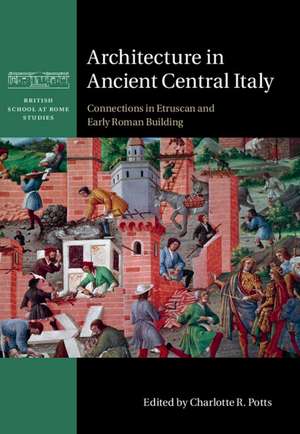Architecture in Ancient Central Italy: Connections in Etruscan and Early Roman Building: British School at Rome Studies
Editat de Charlotte R. Pottsen Limba Engleză Hardback – 6 apr 2022
Preț: 583.91 lei
Preț vechi: 656.07 lei
-11% Nou
Puncte Express: 876
Preț estimativ în valută:
111.73€ • 116.65$ • 92.47£
111.73€ • 116.65$ • 92.47£
Carte tipărită la comandă
Livrare economică 05-19 aprilie
Preluare comenzi: 021 569.72.76
Specificații
ISBN-13: 9781108845281
ISBN-10: 1108845282
Pagini: 224
Ilustrații: 42 colour illus. 5 maps
Dimensiuni: 174 x 251 x 17 mm
Greutate: 0.56 kg
Ediția:Nouă
Editura: Cambridge University Press
Colecția Cambridge University Press
Seria British School at Rome Studies
Locul publicării:Cambridge, United Kingdom
ISBN-10: 1108845282
Pagini: 224
Ilustrații: 42 colour illus. 5 maps
Dimensiuni: 174 x 251 x 17 mm
Greutate: 0.56 kg
Ediția:Nouă
Editura: Cambridge University Press
Colecția Cambridge University Press
Seria British School at Rome Studies
Locul publicării:Cambridge, United Kingdom
Cuprins
1. Introduction: building connections Charlotte R. Potts; 2. The silent roofing revolution: the Etruscan Tie-beam Truss Jean MacIntosh Turfa; 3. Architectural terracottas of central Italy within their wider Mediterranean context Nancy A. Winter; 4. The connective evidence for early Roman urbanism: terracottas and architectural accretion John Hopkins; 5. Connecting foundations and roofs: the Satricum sacellum and the S. Omobono sanctuary Patricia S. Lulof and Loes Opgenhaffen; 6. Architectural choices in Etruscan sacred areas: Tarquinia in its Mediterranean setting Giovanna Bagnasco Gianni; 7. Connections in death: Etruscan tomb architecture, c.800-400 BC Stephan Steingräber.
Descriere
Reconnects ancient buildings with the people who made them, with their surroundings, and with practices in other times and cultures.










